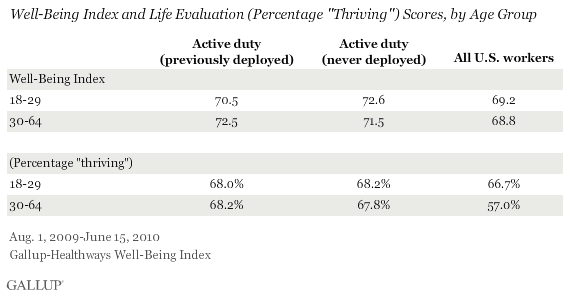This article is the second in a multipart series on the well-being of the American military. covered active duty military and veteran well-being.
WASHINGTON, D.C. -- Active duty military personnel who have ever been deployed to a foreign war have strikingly similar well-being levels as active duty personnel who have never been deployed. In both cases, these levels exceed the well-being scores found among U.S. workers in general.

Active duty military personnel who have been deployed are also as likely to rate their lives well enough to be considered "thriving" as those who have not been deployed. Both groups are significantly more likely to be thriving than are American workers overall.
These findings are based on 86,262 interviews with employed Americans aged 18 to 64, from Aug. 1, 2009-June 15, 2010, which were conducted as part of the . Of these completed surveys, 1,451 were with active duty military personnel between the ages of 18-64 who were residing in the United States at the time they were interviewed, 1,004 of which that had previously been deployed to a foreign war. (Actual combat experience is not determined.)
For more information on what each sub-index of the Gallup-Healthways Well-Being Index comprises, see page 2.
Young military personnel who have been deployed, however, suffer from a slight drop in well-being scores compared with their counterparts who have never been deployed, but they still maintain higher well-being scores than U.S. workers in general. Those deployed older than 30, who ordinarily would experience a decline in life evaluation as a result of advancing age, instead demonstrate resilience on this metric not found among U.S. workers in general and match their younger counterparts' scores.

Bottom Line
Despite the challenges of serving abroad in a foreign war, American military personnel surpass American workers in overall well-being levels regardless of deployment status. While life evaluation clearly holds up regardless of age, the drop in overall well-being among those aged 18 to 29 indicates that foreign war deployment is having an impact on well-being overall.
Learn more about the .
Survey Methods
Results are based on telephone interviews with 86,262 national employed adults, aged 18 and older, conducted Aug. 1 2009-June 15, 2010, as part of the Gallup-Healthways Well-Being Index. Of those surveyed, 1,451 are currently active duty in the U.S. military, including 1,004 who have been deployed to a foreign war and 428 who have never been deployed. (The deployment status of the remainder is unknown.) For results based on the total sample of national adults, one can say with 95% confidence that the maximum margin of sampling error is 卤0.4, +3.0, +3.7, and +5.6 percentage points, respectively. Error ranges will climb higher for individual age groups within each category.

Questions used to discern military involvement and deployment to foreign wars include:
"Have you, or has any member of your household, ever served in the U.S. military?
"Are you currently on active duty, or not?"
"Which war or wars, if any, have you been deployed to?"
Interviews are conducted with respondents on landline telephones (for respondents with a landline telephone) and cellular phones (for respondents who are cell phone only and cell phone mostly).
In addition to sampling error, question wording and practical difficulties in conducting surveys can introduce error or bias into the findings of public opinion polls.
About the Gallup-Healthways Well-Being Index
The Gallup-Healthways Well-Being Index measures the daily pulse of U.S. well-being and provides best-in-class solutions for a healthier world. To learn more, please visit .
